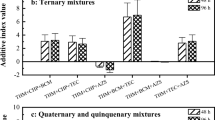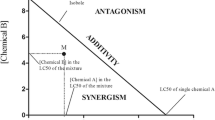Abstract
Background, aim and scope
The ergosterol biosynthesis-inhibiting (EBI) fungicide prochloraz can enhance the effect of other pesticides in a range of animal species. Approximately 50% of the fungicides used in Denmark are EBI fungicides. Hence, if they all have synergising potential, a risk assessment of pesticide mixtures based on additivity might not suffice. This study investigates the synergising potential of six different EBI fungicides representing the imidazoles (prochloraz), the triazoles (epoxiconazole, propiconazole and tebuconazole), the piperidines (fenpropidin) and the morpholines (fenpropimorph) together with the pyrethroid insecticide alpha-cypermethrin.
Materials and methods
Tests were made on the aquatic crustacean Daphnia magna. Mixtures of each of the fungicides were tested together with the insecticide both at a 50:50% effect mixture ratio and, subsequently, in a ray design including five mixture ratios. The results were tested against the concentration addition reference model using dose–response surface analyses.
Results
The results of the binary dose–response surface studies showed that mixtures with prochloraz increased toxicity up to 12-fold compared with what was expected using the reference model concentration addition (CA). Epoxiconazole and propiconazole enhanced toxicity up to six and sevenfold, respectively. Fenpropimorph showed antagonism, whilst mixtures with tebuconazole and fenpropidin did not deviate statistically from CA.
Conclusions
Hence, it can be concluded that both imidazoles and some, but not all, triazoles can enhance the effect of a pyrethroid insecticide towards D. magna substantially. Epoxiconazole and propiconazole are often sprayed out together with pyrethroids in tank mixtures. The extent to which this might create unforeseen ecological problems is discussed.


Similar content being viewed by others
References
Altenburger R, Backhaus T, Boedeker W, Faust M, Scholze M, Grimme LH (2000) Predictability of the toxicity of multiple chemical mixtures to Vibrio fischeri: mixtures composed of similarly acting chemicals. Environ Toxicol Chem 19:2341–2347
Belden JB, Gilliom RJ, Lydy MJ (2007) How well can we predict the toxicity of pesticide mixtures to aquatic life? Integrated Environmental Assessment and Management 3:364–372
Berenzen N, Hümmer S, Liess M, Schulz R (2003) Pesticide peak discharge from wastewater treatment plants into streams during the main period of insecticide application: ecotoxicological evaluation in comparison to runoff. Bull Environ Contam Toxicol 70:891–897
Berthelsen M, Fenger J (2005) Naturens Kemi. Gyldendal, Copenhagen
Bödeker W, Altenburger R, Faust M, Grimme LH (1990) Methods for the assessment of mixtures of plant protection substances (pesticides): mathematical analysis of combination effects in phytopharmacology and ecotoxicology. Nachrichtenbl Deut Pflanzenschutzd 42:70–78
Brande-Lavridsen N, Christensen-Dalsgaard J, Korsgaard B (2008) Effects of prochloraz and ethinylestradiol on sexual development in Rana temporaria. J Exp Zool, Part A Ecol Genet Physiol 309A:389–398
Cedergreen N, Kamper A, Streibig JC (2006) Is prochloraz a potent synergist across species? A study on bacteria, daphnia, algae and higher plants. Aquat Toxicol 78:243–252
Cedergreen N, Kudsk P, Mathiassen SK, Sørensen H, Streibig JC (2007) The reproducability of binary mixture toxicity studies. Environ Toxicol Chem 26:149–156
Cedergreen N, Christensen AM, Kamper A, Kudsk P, Matthiasen S, Streibig JC, Sørensen H (2008) A review of independent action as a reference model for binary mixtures of compounds with different molecular target sites. Environ Toxicol Chem 27:1621–1632
Chalvet-Monfray K, Belzunces LP, Colin ME, Fléche C, Sabatier P (1996) Synergy between deltamethrin and prochloraz in bees: modeling approach. Environ Toxicol Chem 15:525–534
Copping LG, Hewitt HG (1998) Chemistry and mode of action of crop protection agents. The Royal Society of Chemistry, Cambridge
Danish Environmental Protection Agency (2008) Bekæmpelsesmiddelstatistik 2007. Danish EPA, Copenhagen
Deneer JW (2000) Toxicity of mixtures of pesticides in aquatic systems. Pest Manage Sci 56:520
de Jonge H, Jacobsen OH, de Jonge LW, Moldrup P (1998) Particle-facilitated transport of prochloraz in undisturbed sandy loam soil columns. J Environ Qual 27:1495–1503
DMU (2004) Database of monitoring data of surface water pesticide concentrations. National Environmental Research Institute, Silkeborg
Egaas E, Sandvik M, Fjeld E, Källqvist T, Goksøyr A, Svensen A (1999) Some effects of the fungicide propiconazole on cytochrome P450 and glutathione S-transferase in brown trout (Salmo trutta). Comp Biochem Phys C 122:337–344
Elsaesser D, Schulz R (2008) Mitigation of fungicide pollution in vegetated agricultural surface waters: GIS modelling and monitoring in the field. Conference proceeding from the SETAC Europe 18th Annual Meeting, SETAC, Warsaw, pp 406–407
Faust M, Altenburger R, Boedeker W, Grimme LH (1994) Algal toxicity of binary combinations of pesticides. Bull Environ Contam Toxicol 53:134–141
Faust M, Altenburger R, Backhaus T, Blanck H, Boedeker W, Gramatica P, Hamer V, Scholze M, Vighi M, Grimme LH (2001) Predicting the joint algal toxicity of multi-component s-triazine mixtures at low-effect concentrations of individual toxicants. Aquat Toxicol 56:13–32
Faust M, Altenburger R, Backhaus T, Blanck H, Boedeker W, Gramatica P, Hamer V, Scholze M, Vighi M, Grimme LH (2003) Joint algal toxicity of 16 dissimilarly acting chemicals is predictable by the concept of independent action. Aquat Toxicol 63:43–63
Greco WR, Bravo G, Parsons JC (1995) The search for synergy: a critical review from a response surface perspective. Pharm Rev 47:332–385
Hassold E, Backhaus T (2009) Chronic toxicity of five structurally diverse demethylase-inhibiting fungicides to the crustacean Daphnia magna: a comparative assessment. Environ Toxicol Chem 28:1218–1226. doi:10.1897/08-339.1
Hewlett PS (1969) Measurement of the potency of drug mixtures. Biometrics 25:478–487
Johnston G, Walker CH, Dawson A (1994) Interactive effects between EBI fungicides (prochloraz, propiconazole and penconazole) and OP insecticides (dimethoate, chlorpyrifos, diazinon and malathion) in the hybrid red-legged partridge. Environ Toxicol Chem 13:615–620
Kennaugh L, Pearce D, Daly JC, Hobbs AA (1993) A piperonyl butoxide synergizable resistance to permethrin in Helocoverpa armigera which is not due to increased detoxification by cytochrome P450. Pest Biochem Physiol 45:234–241
Kronvang B, Iversen HL, Vejrup K, Mogensen BB, Hansen A, Hansen LB (2003) Pesticides in streams and subsurface drainage water within two arable catchments in Denmark: pesticide application, concentration, transport and fate. Danish Environmental Protection Agency, Copenhagen
Larsbo M, Aamlid TS, Persson L, Jarvis N (2008) Fungicide leaching from golf greens: effects of root zone composition and surfactant use. J Environ Qual 37:1527–1535
Liess M, Schulz R, Liess MHD, Rother B, Kreuzig R (1999) Determination of insecticide contamination in agricultural headwater streams. Water Res 33:239–247
Martin JD, Crawford CG, Larson SJ (2003) Pesticides in streams. National Water Assessment Program (NAWQA), USA
Meled M, Thrasyvoulou A, Belzunces LP (1998) Seasonal variation in susceptibility of Apis mellifera to the synergistic action of prochloraz and deltamethrin. Environ Toxicol Chem 17:2517–2520
Mougin C, Polge N, Scalla R, Cabanne F (1991) Interactions of various agrochemicals with cytochrome P-450-dependent monooxygenases of wheat cells. Pest Biochem Physiol 40:1–11
OECD Guideline for Testing of Chemicals (2004) Daphnia sp., acute immobilization test no. 203, OECD, Paris
Papaefthimiou C, Theophilidis G (2001) The cardiotoxic action of the pyrethroid insecticide deltamethrin, the azole fungicide prochloraz, and their synergy on the semi-isolated heart of the bee Apis mellifera macedonica. Pesticide Biochem Physiol 69:77–91
Pilling ED, Jepson PC (1993) Synergism between EBI fungicides and a pyrethroid insecticide in the honeybee (Apis mellifera). Pestic Sci 39:293–297
Pilling ED, Bromley-Challanor KAC, Walker CH, Jepson PC (1995) Mechanism of synergism between the pyrethroid insecticide lamda-cyhalothrin and the imidazole fungicide prochloraz in the honeybee (Apis mellifera L.). Pest Biochem Physiol 51:1–11
R Development Core Team (2004) R: A language and environment for statistical computing. R Foundation for Statistical Computing, Vienna
Ritz C, Streibig JC (2005) Bioassay analyses using R. Journal of Statistical Software 12:1–22
Sørensen H, Cedergreen N, Skovgaard I, Streibig JC (2007) An isobole-based statistical model and test for synergism/antagonism in binary mixture toxicity experiments. Environ Ecol Stat 14:383–398
Taxvig C, Vinggaard AM, Hass U, Axelstad M, Metzdorff S, Nellemann C (2008) Endocrine-disrupting properties in vivo of widely used azole fungicides. Int J Androl 31:170–176
Thompson HM (1996) Interactions between pesticides: a review of reported effects and their implications for wildlife risk assessment. Ecotoxicology 5:59–81
Tomlin CDS (2002) The e-pesticide manual. British Crop Protection Council, Surrey
Vandame R, Belzunces LP (1998) Joint actions of deltamethrin and azole fungicides on honey bee thermoregulation. Neurosci Lett 251:57–60
Venkatakrishnan K, von Moltke LL, Greenblatt DJ (2000) Effects of the antifungal agents on oxidative drug metabolism—clinical relevance. Clin Pharmacokinet 38:111–180
Acknowledgement
We thank BASF and Cheminova for providing technical pesticides and Christian Ritz for modifying the model of Sørensen et al. (2007) for binominal data.
Author information
Authors and Affiliations
Corresponding author
Additional information
Responsible editor: Thomas Braunbeck
Appendix I
Appendix I
Rights and permissions
About this article
Cite this article
Nørgaard, K.B., Cedergreen, N. Pesticide cocktails can interact synergistically on aquatic crustaceans. Environ Sci Pollut Res 17, 957–967 (2010). https://doi.org/10.1007/s11356-009-0284-4
Received:
Accepted:
Published:
Issue Date:
DOI: https://doi.org/10.1007/s11356-009-0284-4




